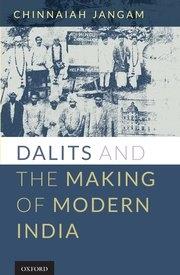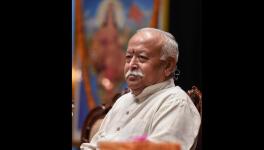Dalit Imagination: An Antidote to Communal Nationalism

Contemporary India is witnessing the appropriation by the Hindu right of the idea of nationalism and its use as a tool to undermine the legiti-mate claims of the deprived sections for justice, equity, equality, and dignity. Historical reading and the study of the writings and activities of Dalits demonstrates that the contemporary trajectory is a continuation of the historical legacy of the caste Hindu Brahmanical imagination embedded in the idea of nation in India. The ‘dominant voice [in this context that of caste Hindu elites] in the discourse of power persistently and deceitfully insists that responsibility for suffering must be acknowl-edged by the sufferer himself or herself’. Beginning with the colonial state’s half-hearted policy initiatives and continuing to Gandhi’s efforts towards the uplift of Harijans, rhetoric of pity or compassion for the suffering Dalits was created. Instead of acknowledging that the root cause of the misery of Dalits lay within the Hindu Brahmanical ideol-ogy in which the caste Hindu elites were complicit, the onus for their lot was placed on Dalits themselves. Caste Hindu elites blithely prescribed a Sanskritization model as a solution for the misery of Dalits, ignoring the fact that the Hindu Brahmanical hierarchical caste ideology based on birth would not have a place for Dalits and would not recognize them as human beings. In response, Dalits as bearers of the stigma of untouchability and suffering under the weight of social and economic deprivation wove themes about their suffering, not to gain pity, but to expose the immoral nature of Hindu religious philosophy and its social practices backed by the so-called sacred texts. In contemporary India, the power of Dalits’ political imagination is displayed in their growing radicalism in response to Hindu communalism. This current assertion represents a spot on a continuum of anti-caste activities by Dalits dating from the pre-colonial and colonial past.
Invincible Imagination
The Manusmriti is an ancient law text followed for centuries by the caste Hindu ruling elites. It was one of the earliest documents translated by Sir William Jones in 1894. It was relied upon as an authoritative text in the formulation of Hindu law and used in the moulding of the colonial understanding of caste in India. The rights to produce and disseminate knowledge, including reading and analysing texts, belonged exclusively to Brahmans and other elite castes. It is remarkable to see the way caste Hindus across all sub-castes, including illiterate Sudras, followed the dictates of the Manusmriti in their social interactions, even though they were denied access to education and reading of the text. The Manusmriti stated:
Candalas [Dalits] property consists of dogs and donkeys, their garments are the clothes of the dead; they eat in broken vessels; their ornaments are of iron, and they constantly roam about.
A man who follows the Law should never seek any dealings with them. All their transactions shall be among themselves, and they must marry their own kind. They depend on others for their food, and it should be given in broken vessel. They must not go about in the vil-lages and towns at night; they may go around during the day to perform some tasks at the command of the king, wearing distinguishing marks. They should carry away the corpses of those without relatives—that is the settled rule. They should always execute those condemned to death in the manner prescribed by authoritative texts and at the command of the king; and they may take the clothes, beds, and ornaments of those condemned to death.
The tenets of the Manusmriti were transmitted orally as part of a child’s upbringing to be accepted as norms and ritual practices in Hindu society. In this way, social exclusion along with the denial of human dig-nity and economic opportunity became a natural part of Brahmanical epistemology. Such inhuman prescriptions legitimized by religious phi-losophy were hidden from its victims (by the denial of education) not just as a privilege, but also as a protective cover. Impossible to imagine a victim reading codes of his/her own oppression! To those outside the Hindu Brahmanical world, especially the colonizers, the complex caste rules and religious rituals were bewildering, but pragmatic consider-ations made it easier to collude with the ruling elites, than to challenge. In this way, the success of colonialism on the Indian sub-continent was dependent on an understanding between colonial and nationalist elites. Superficially, from the standpoint of Dalits and other marginalized groups, both these parties represented the same oppres-sive and exploitative institutions. However, the dynamism of colonial exploitation and the accompanying racial hierarchies subordinated and humiliated the indigenous elites and this acted as a trigger for an anticolonial consciousness.Thus the anti-colonial nationalism that envisaged the leadership of caste Hindus eliminating colonialism from Indian soil also assumed the nation as their prerogative and the status quo as representing the national culture. They internalized Brahmanical philosophy to such a degree that they were oblivious to the sufferings of their fellow Indians (Dalits and other oppressed communities). Dalits, on the other hand, used imaginative articulations and political action to puncture the stock nationalist assumptions and replaced them with an anti-caste egalitarian ethic as the basis for national culture.
Paul Gilroy in analysing the encounter of blacks with colonial modernity observed that to be both European and black requires some specific forms of double consciousness. Similarly, Dalit encounters with colonialism and their entrapment in pre-colonial forms of oppres-sion required a ‘double consciousness’ as Dalit (an anti-caste) and also as a nationalist (modern) using their experience as basis for rei-magining an ethical nation distinct from the Hindu Brahmanical imag-ination. That is why a Dalit imagines himself/herself through the lens of stigmatized existence as anti-caste and as person emancipated by the Enlightenment as an equal citizen. Thus a Dalit nationalist figure escapes from the pre-colonial oppression and emerges as an anti-caste modern being ready to articulate a new egalitarian social and politi-cal order. This is the explanation of why the preeminent Dalit thinker B. R. Ambedkar burnt a copy of the Manusmriti at a public event on 25 December 1927. The anti-caste ethic can be viewed as the backbone of Dalit aspirational politics and ideas across India, including the Telugu-speaking areas. Moreover, Dalits imagined anti-caste ethical nation-alism as part of an anti-colonial nationalist movement. This is why Ambedkar argued that ‘there are two nations: Puruskrut Bharat (ideal, pure [conceived by caste Hindus]) and Bahiskrut Bharat (actual, pol-luting India [consisting of untouchables and other marginalized com-munities]). He proposed Prabuddha Bharat (enlightened and inclusive India). Dalit political imagination, despite its diversity in terms of language, region, and political means, was united in the desire for the establishment of an egalitarian and inclusive society. The Constitution of India, crafted by Ambedkar, proclaimed in the preamble that the foundational principles of the nation were considered to be justice, lib-erty, equality, and fraternity, not the Manusmriti’s dehumanizing caste code. However, in India, the lived experience of Dalits has proven to be the contrary, at every level. This does not mean that Dalits have surrendered to their oppressors; on the contrary, they stand out as an example for the subjugated humanity as they used their imaginative power and asserted themselves against injustice and the inhumanity of the caste system. Even in death, they have refused to accept indignity, and the death of Rohith Vemula demonstrates further the power of their imagination as an invincible force, which will shape the future of India.
Chinnaiah Jangam teaches in the Department of History, Carleton University, Canada. He is a historian specialising in modern south Asian social and intellectual history.
Get the latest reports & analysis with people's perspective on Protests, movements & deep analytical videos, discussions of the current affairs in your Telegram app. Subscribe to NewsClick's Telegram channel & get Real-Time updates on stories, as they get published on our website.
























